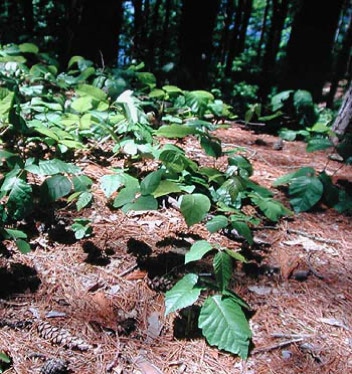Poison Ivy
What is it?
Poison Ivy is also known as contact dermatitis. Contact dermatitis is basically an allergic reaction in the skin due to a chemical exposure on the skin. The chemical that causes the reaction can be from Poison Ivy, Poison Oak, Poison Sumac, or a variety of other plants. The rash from a chemical burn often looks similar.
This picture exhibits one of the hallmarks of poison ivy which is linear streaks of blisters. Notice there is little redness, but often there is quite a bit of redness depending on your skin type.
What causes it?
The chemical that causes the reaction is actually on the stem of the plant and not the leaf, and this is why we see so many cases in the winter when the leaf is not evident. The common name for the chemical is Rhus Oil. This chemical can get on clothing, shoes, belts, the coat of a pet, baseballs, etc, and can still cause the same skin reaction if touched months later.
Is Poison Ivy contagious?
No. The “oil” produced in the skin blisters is just body fluid. Your body has no means of duplicating the Rhus Oil. Once your exposed to the chemical, you will break out over a 3-day period. The heaviest exposure usually breaks out first, but you will still get new lesions for up to 3 days from a single exposure. This is why many people think it spreads, but it doesn’t. If you’re still breaking out after 3 days, then you’re still being exposed to the oil and therefore you should check shoes, belts, toys, etc, that could have the oil on it.
What is the normal course of an outbreak?
The typical course of Poison Ivy lasts 14-21 days. It’s never gone in under 10 days. There is no treatment that can reduce the length of the outbreak. Treatments only reduce severity and relieve symptoms.
How do you prevent Poison Ivy?
There was an allergy injection that helped prevent outbreaks, but it was discontinued in 1992 or 1993. If you know you’re going to be exposed, then use Ivy Block to prevent the Rhus Oil from contacting your skin. Ivy Block is a commercially available chemical barrier. Once you have been in Poison Ivy, then wash all exposed areas and wash all clothing that was exposed. If you could not wash within the first 2 hours after exposure, and it’s not been more than 6 hours, then wash and apply rubbing alcohol to the exposed areas. Rubbing alcohol neutralizes the Rhus Oil. For the clothing that can’t be washed, use Rubbing alcohol to neutralize the Rhus Oil. If it’s been longer than 6 hours from exposure, there is nothing you can do to prevent the outbreak.
How do we treat it?
This can be separated into Over The Counter (OTC) oral itch medicines, OTC topical anti-itch medicines, prescription oral itch medicines and prescription steroids. CAUTION: Do not put Bleach on the Poison Ivy Outbreak. Bleach will not make it go away quicker and can damage the skin
OTC ORAL ANTI-ITCH: The only one available is Benedryl (diphenhydramine). This antihistamine has been around for over 50 years and is extremely safe. Approximately 10% get quite drowsy with it (not exactly a bad thing with Poison Ivy), but 10% will get hyper on this medicine. Sometimes these reactions are from the food coloring and not the medicine; therefore you might try the Benedryl Clear, which has no food coloring.
OTC TOPICAL ANTI-ITCH: Epsom Salt or oatmeal baths are still very effective, but only last for a short time. Calamine Lotion has been around for a very long time and is still very effective. Caladryl is simply Calamine with a numbing type medicine added in to make it more effective. Caladryl used to contain diphenhydramine, and this sometimes caused the person using it to become allergic to the oral version of diphenhydramine (Benedryl). Caladryl no longer contains diphenhydramine, but some people will still tell you not to use it due to this outdated reason. Shake Lotion is a mixture of calamine and other ingredients that local pharmacists make. This is the most effective topical lotion for itch. Shake Lotion is available over the counter, but not all pharmacies make it. There are a variety of other concoctions for Poison Ivy, but the above are the most commonly used.
PRESCRIPTION ANTI-ITCH: Atarax is the strongest oral anti-itch medicine available short of sedation. You cannot use Benedryl and Atarax together. Atarax is basically like extra strength Benedryl and is roughly 15-20% better, but may be more sedating at the same time.
PRESCRIPTION STEROIDS: These are only given after the child is examined in the office. Steroids will reduce the severity of the outbreak, but will not shorten it. We mainly use Steroids with severe cases of Poison Ivy or in kids prone to severe cases. Steroids greatly increase the chance for infection and are only used in severe cases and when we are sure there is no infection present. If your child has had steroids for Poison Ivy in the past and you think this outbreak may be bad, call the office as soon as possible to be seen. The sooner the steroids are started the better they work.
When should I call the doctor?
If the skin looks infected
If there is significant swelling
If you feel your child needs something stronger than Benedryl for the itch.
A special note about FEVER BLISTERS
Since Poison Ivy causes a break in the skin, it makes a skin infection much more likely to occur. Fever blisters (herpes labialis) can invade the open wound and cause a significant and painful infection. Once you get a fever blister infection in a location (like the lip, fingers, cheeks), then it may come back in that area over and over again. Be very careful not to touch a fever blister then touch the open wound or let someone kiss an open wound with a fever blister.




